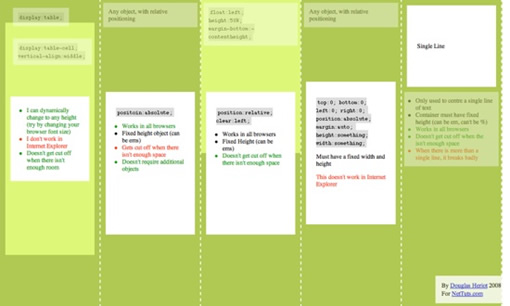制作師專(zhuān)欄
CSS實(shí)現(xiàn)垂直居中的5種方法
利用 CSS 來(lái)實(shí)現(xiàn)對(duì)象的垂直居中有許多不同的方法,比較難的是選擇那個(gè)正確的方法
。我下面說(shuō)明一下我看到的好的方法和怎么來(lái)創(chuàng)建一個(gè)好的居中網(wǎng)站。
使用 CSS 實(shí)現(xiàn)垂直居中并不容易
。有些方法在一些瀏覽器中無(wú)效
。下面我們看一下使對(duì)象垂直集中的5種不同方法,以及它們各自的優(yōu)缺點(diǎn)
。(可以看看 測(cè)試頁(yè)面 ,有簡(jiǎn)短解釋
。)

方法一
這個(gè)方法把一些 div 的顯示方式設(shè)置為表格
,因此我們可以使用表格的 vertical-align property 屬性
。
<div id="wrapper">
<div id="cell">
<div class="content">
Content goes here</div>
</div>
</div>
#wrapper {display:table;}
#cell {display:table-cell; vertical-align:middle;}
優(yōu)點(diǎn):
content 可以動(dòng)態(tài)改變高度(不需在 CSS 中定義)
。當(dāng) wrapper 里沒(méi)有足夠空間時(shí), content 不會(huì)被截?cái)?/p>
缺點(diǎn):
Internet Explorer(甚至 IE8 beta)中無(wú)效
,許多嵌套標(biāo)簽(其實(shí)沒(méi)那么糟糕,另一個(gè)專(zhuān)題)
方法二:
這個(gè)方法使用絕對(duì)定位的 div
,把它的 top 設(shè)置為 50%
,top margin 設(shè)置為負(fù)的 content 高度。這意味著對(duì)象必須在 CSS 中指定固定的高度
。
因?yàn)橛泄潭ǜ叨龋蛟S你想給 content 指定 overflow:auto
,這樣如果 content 太多的話,就會(huì)出現(xiàn)滾動(dòng)條,以免content 溢出。<div class="content">
Content goes here</div>
#content {
position:absolute;
top:50%;
height:240px;
margin-top:-120px; /* negative half of the height */
}
優(yōu)點(diǎn):
適用于所有瀏覽器
不需要嵌套標(biāo)簽
缺點(diǎn):
沒(méi)有足夠空間時(shí),content 會(huì)消失(類(lèi)似div 在 body 內(nèi)
,當(dāng)用戶(hù)縮小瀏覽器窗口,滾動(dòng)條不出現(xiàn)的情況)
網(wǎng)站建設(shè) 網(wǎng)站制作 網(wǎng)頁(yè)設(shè)計(jì) 網(wǎng)站建設(shè)公司 沈陽(yáng)網(wǎng)站建設(shè) 沈陽(yáng)網(wǎng)頁(yè)設(shè)計(jì) 高端網(wǎng)站設(shè)計(jì) 沈陽(yáng)網(wǎng)站制作公司 高端網(wǎng)站建設(shè) 沈陽(yáng)網(wǎng)絡(luò)公司 沈陽(yáng)網(wǎng)站制作
沈陽(yáng)易勢(shì)科技有限公司 © 2006-2013 , All rights reserved. 遼B2-20150173-8




































































































